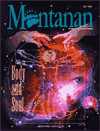
FALL 1999
CONTENTS
Keeping the Student Body Fit Harvest Moon
The Human Side of Medicine
AROUND THE OVAL
SPORTS
CLASS NOTES
ALUMNI NOTES
Contact Us
About the Montanan
PAST ISSUES
 FALL 1999 CONTENTS Keeping the Student Body Fit Harvest Moon The Human Side of Medicine
AROUND THE OVAL Contact Us About the Montanan PAST ISSUES |
The Human Side of MedicineThe Institute of Medicine and Humanities by Cary Shimek
by Cary Shimek
Dr. John Stone went through a life change when he turned forty. A successful cardiologist at Missoula’s St. Patrick Hospital, he became increasingly fixated on the ethical questions that arise in hospitals. Are doctors pressured to provide procedures that may be unnecessary? Are health care workers practicing medicine for the right reasons? Stone also felt adrift in an increasingly technical field that seemed to be losing touch with the human face of health care. This restlessness led him to take a yearlong series on the history of philosophy from UM Professor Dick Walton. The two enjoyed the knotty philosophical discussions that arose in class, so in 1987 they started an informal reading group of hospital health care practitioners and UM faculty. “It was rewarding for me because I could learn about concrete examples of the philosophical issues that arise in medicine,” Walton says. “We had one doctor, for example, who had to work with a Jehovah’s Witness girl whose parents--because of religious convictions--wouldn’t let her have a blood transfusion.” The group became so successful that participants formed the Institute of Medicine and Humanities. A cooperative venture between St. Patrick Hospital and UM, IMH has flowered into an organization that supports learning and studies in the humanities--especially studies that shed light on the way society cares for the sick. In the past, IMH has sponsored five medicine and humanities programs per year, including a large, annual fall symposium and a variety of ad hoc programs. An eleven-member executive board that includes hospital President Larry White and UM President George Dennison keeps fresh energy flowing into the organization. All involved say White has been instrumental in developing IMH into the vital program it is today. “When health care providers rely only on immersion in their science, we risk becoming detached from the human side of the enterprise,” White says. “I think a deeper understanding of the lessons of the humanities results in improved health care, a renewed professional commitment and enhanced personal fulfillment.” During the 1997 fall conference titled “Genethics: Critical Issues in Gene Technology,” participants discussed the ethics of experimenting with the basic code of life. A 1997 series presented images of war in literature and art with the purpose of promoting understanding and healing. A conference in 1996 found physicians exploring the role spirituality plays in their work and community members describing how they cope with their disabilities. IMH also oversees a collection of journals and 1,200 books in medicine and the humanities that are available to the public. IMH coordinator Dixie Goeres-McLaughlin said one highlight of the library is a collection of pathographies, autobiographies of personal illnesses, which give physicians a personal perspective of what patients go through. IMH currently is conducting a national search for an executive director, a position that was filled by Jan Willms for seven years. Willms retired last August. At this time the institute’s only paid staff member is Goeres-McLaughlin. Based on the feedback she has received, Goeres-McLaughlin believes that many from UM, St. Patrick Hospital and the community have been enriched by IMH. Certainly that was the case with cardiologist Stone, whose investigations into the moral questions surrounding medicine prompted him to leave Missoula in 1992 to pursue a doctoral degree in philosophy. He now is a senior staff associate with the National Center for Bioethics in Research and Health Care at Tuskegee University.
AROUND THE OVAL• SPORTS • CLASS NOTES • ALUMNI NOTES FEEDBACK•STAFF • ABOUT THE MONTANAN •ARCHIVES HOME • CONTENTS
|